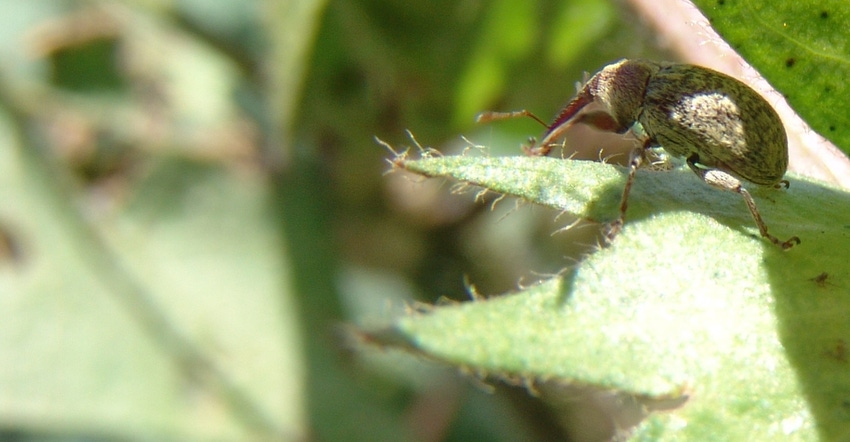
Recently two Mexican boll weevils were trapped near Batesville, Miss., in Panola County. How they got there no one knows for sure but boll weevil personnel have increased trapping schedules near the spot where the two weevils were found.
“We know they were identified as boll weevils and they were two males,” says Larry Smith, Texas Boll Weevil Eradication program director, who’s been in contact with some of the Mississippi program managers about the origin of the weevils. “Right now, it’s in the investigative stage.”
Smith says investigations conducted throughout the years have revealed how re-infestations occur, often traced back to vehicles, module trucks or harvest equipment that have previously been in an active boll weevil zone. “You never know how weevils can move. Everybody automatically thinks equipment, but they can move in many different ways.”
Wind also can be a culprit. For example, along the Rio Grande Valley, where the summer winds primarily blow southeast to northwest, Smith says there is a migration effect from active zones in Tamaulipas, Mexico, to nearby Texas fields, an issue both Mexico and the U.S. are working to resolve.
Boll weevil traps are not only strategically placed in fields but at truck stops and roadside parks and in areas where migration of field laborers occurs, moving from one field to another.
Female weevils can lay up to 200 eggs, laying each egg in a separate cotton square or boll. The entire life cycle, from egg to adult, can be completed in three weeks or less resulting in five or more generations per year.
While 97 percent of the cotton grown in the U.S. is weevil free, Smith says everyone must be diligent to make sure weevils don’t repopulate.
“In Texas, we work in cooperation with USDA and TDA to inspect equipment coming out of weevil areas,” Smith says. “We have over 7 million acres that are eradicated and we don't want weevils moving into those areas, so we closely scrutinize all the equipment moving out of the quarantined areas. And with all the equipment movement we've had this year, luckily, we have not seen anything, but I think part of that is our thorough inspection to make sure there is no cotton material present.”
The Texas quarantine laws help protect our weevil-free areas from someone moving regulated articles from the Lower Rio Grande Valley into all the other cotton growing areas which have been declared eradicated, says Smith.
According to the Texas Boll Weevil Eradication website, cotton harvesting equipment and other equipment associated with the production and transport of cotton, as well as gin equipment, may be moved through a restricted area provided the equipment is free of hostable material, seed cotton and boll weevils in any stage of development by one of the following methods:
a. removal by hand;
b. high-pressure air cleaning;
c. high-pressure washing; or
d. fumigation of regulated articles as prescribed by the Texas Department of Agriculture.
Once the machinery has been cleared, the owner is issued a certificate. “There are pretty high fees if you’re caught moving out of one of those areas without getting the necessary documentation or cleaning the equipment,” Smith says.
While TDA monitors the highways for dirty harvest equipment, Smith says, local producers are often some of our best eyes and ears. “They don't mind picking up the phone and calling us and saying, ‘Hey, I saw some equipment moving down this road.’ And we’ll check it out, make sure they’ve been inspected.”
Just because harvest equipment is dirty, doesn’t necessarily mean it’s weevil free, it may have been fumigated, which also kills any insects on the machine, says Smith.
To keep custom harvesters on the road and in the field harvesting Texas cotton, Smith says his personnel inspect seven days a week. “Most custom harvesters know to call the foundation,” he says. “And with the wet harvest season we are having, every second is very important. We don't want to delay them by making them wait until Monday to get an inspection.”
You can hear more from Smith about the Texas Boll Weevil Eradication Program at the 2019 Beltwide Cotton Conference next January 8-10 in New Orleans, La. For more information about the foundation or program, visit: https://www.txbollweevil.org/protect.html.
About the Author(s)
You May Also Like






